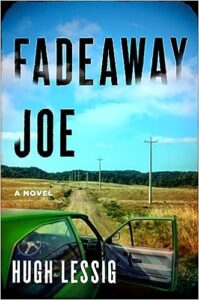I first noticed something wrong with dad one Sunday during a visit. We were watching a football game. I sat on the couch, and he crooked one leg over the padded arm of an easy chair. I don’t recall discussing the game or who was playing. But he suddenly asked a question that hit like a bolt from the blue.
“Is it three downs or four?”
Dad and I had watched football together for more than 40 years. He knew teams had four downs, but I could see he wasn’t kidding. At that time, he was in his mid-seventies, a former truck driver, a star baseball player back in high school, a U.S. Marine who came home from Okinawa after World War II. He was a quiet and kind man who enjoyed reading history.
After that day, I began researching dementia, its causes and effects, what to expect, how to deal. One aspect bothered me more than others: how dementia can lead to aggression or uncontrolled rage. My father was not a violent man. I had seldom heard him raise his voice. I couldn’t imagine seeing him angry.
Years later, I returned to the subject of dementia in my debut novel, Fadeaway Joe. The main character is Joe Pendergast, who is unlike my father in every possible way. Joe is a career criminal, a bouncer, a professional tough guy and a collector of bad debts.
Diagnosed with early-stage dementia, he’s been cast aside by his boss, Maxie Smith, as someone no longer useful to the criminal organization. Being abandoned by Maxie hurts worse than a sucker punch. Joe’s devotion to Maxie bordered on brotherly love. For 40 years, Joe fetched his boss’s dry cleaning, mixed his drinks and cleaned up his various messes. Joe broke bones for Maxie. He left men dying in ditches.
Now cast aside, Joe moves back to his old neighborhood. He begins operating a food truck to make ends meet, and contemplates vengeance against his old boss. With his diagnosis, he knows the clock is ticking. He needs a plan that’s more nuanced than “fire guns, kill Maxie and go out in a blaze of glory.”
Two impressive women intervene to complicate his plans.
The first is 22-year-old Paula Jessup. She’s street-smart and homeless, on the run from labor traffickers. Paula needs shelter and protection, the kind Joe can provide. Then there’s his new neighbor, Donna, a fortyish real estate agent who is kind, curious and tends to over-share.
Both women witness Joe’s tendency toward casual and calculated acts of violence. Depending on how much money you owe, he can dislocate your thumb or break it. He’s always in control. This is evident when he encounters a couple of hoods looking for Paula. They stumble away from his front door, leaving trails of blood. Donna sees it from next door and runs over to ask why he flew into a rage.
His answer: “That’s not rage, Donna. That’s practice.”
But as his dementia progresses, Joe experiences bouts of uncontrolled rage. It gives the story a chilling edge because he no longer has guardrails. His well-honed penchant for violence is now out of control.
Why do those who suffer from dementia experience bouts of rage, aggression and anger? According to the Alzheimer’s Association, several factors can come into play. A busy or loud environment can result in the person being overstimulated. Some patients function better at certain parts of the day. The caregiver might ask too many questions or give unclear instructions, resulting in frustration.
Early in the story, Joe is researching Paula’s background online, trying to determine if he can trust her. It is late at night and he’s tired. When Donna sees lights on at his house, she walks into his backyard. (Not the best idea, to be fair.) A sleep-deprived Joe sees her and thinks he’s back in Maxie’s bar, working the door as a bouncer, and this strange woman is trying to get past him. He greets her with a loaded gun. Donna, aware of Joe’s diagnosis, carefully talks him down.
In the second instance, Joe has just discovered an old girlfriend has betrayed him. He’s driving with Paula in the passenger seat. By this time, he and Paula have become friends. They have an odd rapport, this young woman and old man. She begins teasing him about the old girlfriend, unaware that it’s a sore spot. Joe suddenly lashes out with a closed fist, bloodying her nose. It’s a minor injury, but in some ways scarier than beating up those two hoods at the front door.
But dementia isn’t just about rage and aggression. It lights a fuse of uncertain length. At what point does Joe end up in a nursing home, or worse? He doesn’t know. He wants vengeance against Maxie before that happens. Then again, is revenge his highest goal? Joe sees something of himself in Paula, a tough young woman whose fortunes are at a crossroads. He becomes reflective about his life. He considers the choices he’s made (almost all bad) and knows he has left a trail of pain, fear and broken bones.
Perhaps his final act can be setting Paula on a new path, not simply protecting her until he’s no longer able. The narrative turns on this concept and leads to a more productive conclusion. Violent, but still productive.
When my dad’s diagnosis was confirmed, I began asking him about his earlier life, filling in gaps he seldom talked about his war service, how he met my mom, his early days as a railroad engineer and his heady days playing baseball. Those moments meant a lot.
Joe shares similar moments with Paula once their friendship matures, and it seems equally satisfying.
I was so pleased when author Rob Hart reviewed this book and commented that it is “the kind of noir I love: smart, tight, and just the right amount of gritty before giving way to the depths of human connection.”
For crime writers, something as devastating as dementia allows you to dig deeper into a character. It’s painful and scary, but it is also rewarding.
***


















